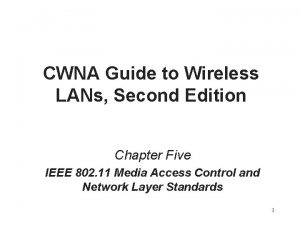Throughput Estimation For Wireless LANs Haynes Cheng Arnel

- Slides: 1

Throughput Estimation For Wireless LANs Haynes Cheng, Arnel Lim, Michael Weatherby University of British Columbia Department of Electrical and Computer Engineering Radio Science Lab III - METHODOLOGY I - OBJECTIVES 1. Indoor Path Loss Model • 2. Evaluate indoor path loss model parameters so that signal strength and carrier/interference (C/I) values can be calculated 1. Path Loss Models and RSSI Prediction 2. Throughput Estimation Static Throughput vs C/I Curves (Previously Measured) C/I Values from Path Loss Model and Simulation Indirect Throughput Estimation • 3. Infer throughput from signal strength and the measured effects of noise on performance 3. Direct throughput measurement • Establish test strategies for obtaining repeatable throughput field-measurements using minimal resources Indirect Method (STPA) • Since we are estimating throughput from calculated C/I, why not use real C/I? • Modify a UBC-developed mapping tool to obtain real signal and interference values for calculating C/I II - BACKGROUND & MOTIVATION 1. How can one predict or measure how well a wireless network will work under heavy load? IV - ACCOMPLISHMENTS 1. Path Loss Model of Indoor Environments (AP vs Client) • 2. Focus on Network Level Testing to Aid Network Administrators 2. Access Point Client • Cell Level • contention • MAC overhead Network Level • mutual interference • power settings • channel assignments 3. Collected and reduced detailed path loss data for multiple AP’s and clients (3 buildings, 40 access points, over 10 000 data points) Indirect Throughput Measurement Link Level • signal quality Throughput Estimation Implemented the indirect method based upon static throughput versus C/I curves Simple Throughput Prediction Algorithm (STPA) • Implemented a simple throughput prediction algorithm using Fatmapper, a UBC-developed mapping tool, as the data collection platform.

